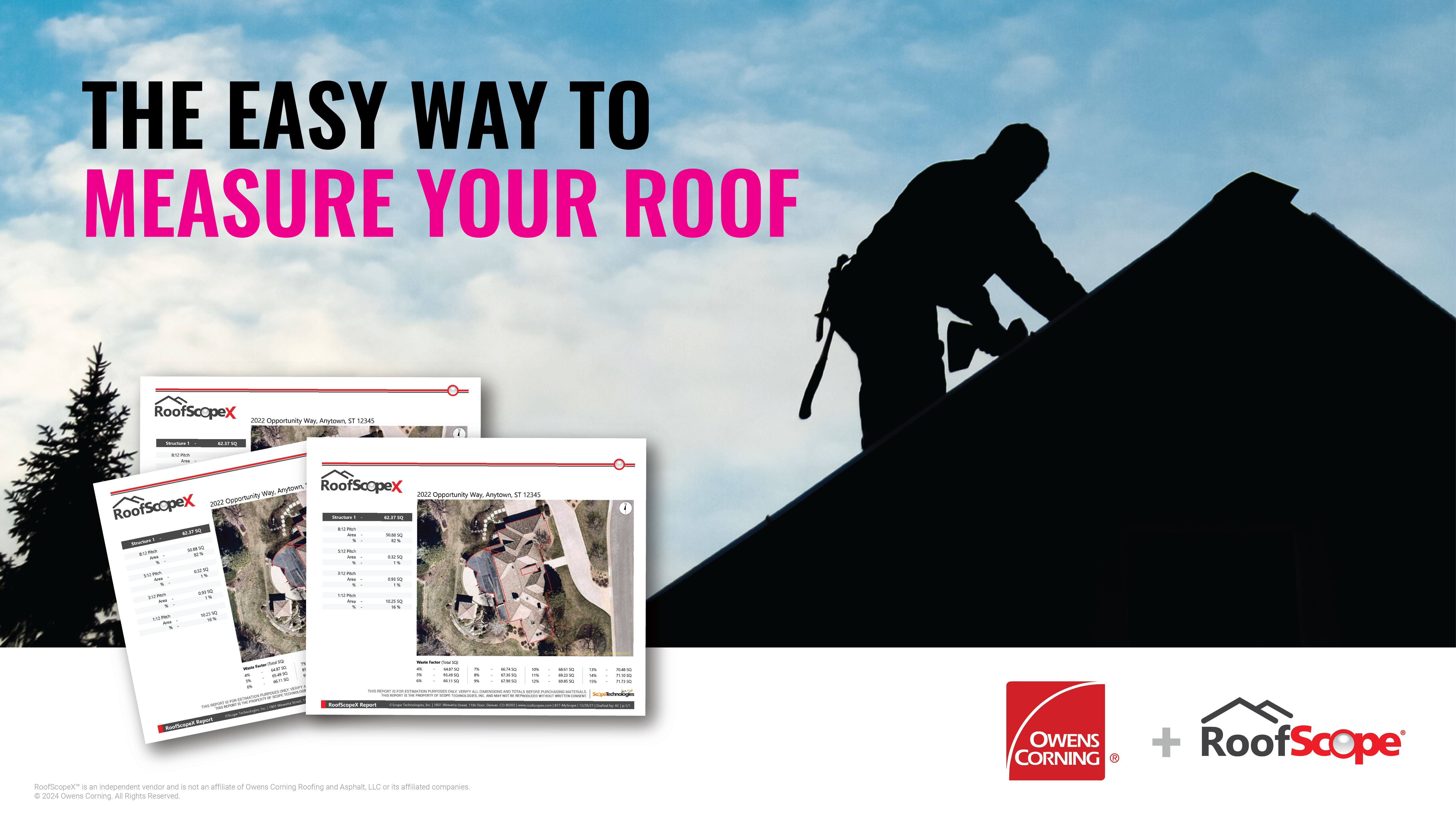
- Roof Replacement
DIY Roofing
Your roof is a major structural component of your home. A successful re-roofing project requires a large investment in both time and money. Since you cannot afford mistakes during installation, we highly recommend you hire a professional roofing contractor.
Find a Roofing Contractor
Search our list of independent roofing contractors in the Owens Corning Roofing Contractor Network to find the roofing professional that’s right for you.
Estimating How Much Roofing Material You Need
If you have decided to do the work on your own, check out our estimating guidelines below and these other Roofing resources:
- Roofing Suppliers – Where to Buy Roofing Materials
- Ventilation Calculator
- How to Nail Roofing Shingles
- Total Protection Roofing System®
- Build Your Roof™
How Many Roofing Shingles Do I Need?
To estimate how much roofing material you need, such as bundles of architectural shingles or rolls of synthetic roofing underlayment, you need to know the total square footage of your roof’s surface.
How to Calculate Total Square Footage of Your Roof
To find your roof’s total square footage:
- Measure the length and width of each plane on the roof (including dormers) then multiply length times width.
- Add the square footage of each of the planes together.
Example #1: Shed Roof with One Roof Plane
For example, this shed roof has one roof plane.

Shed Roof with One Roof Plane
- Multiply length (A) times width (B):
A x B = 40′ x 30′ = 1200 sq. ft. for the total square footage of the roof.
Example #2: Gable Roof with Two Roof Planes
This gable roof has two planes.

So, to derive the total square footage of the roof, you would:
- Multiply length (A) times width (B) and length (A) times width (C) to get the square footage for each plane.
- Add the two planes together.
For example:
- Plane 1 (A x B): 40′ x 30′ = 1200 sq. ft.
- Plane 2 (A x C): 40′ x 30′ = 1200 sq. ft.
- Plane 1 + Plane 2 = 2400 sq. ft. for the total square footage of the roof.
Ready to get an estimate? Find an independent roofing contractor in the Owens Corning Roofing Contractor Network near you.
What is a “Roofing Square”?
Roof surfaces are measured in “squares”. A roofing square is equal to 100 square feet of the roof.
To determine the number of squares on the gable roof example in this post, divide its total of 2400 square feet by 100 (2400 ÷ 100 = 24).
This means you would need 24 squares of shingles to cover that roof. Be sure to add 10%-15% to all your material totals for trim allowance (waste factor).
PRO TIP: Want to skip doing some math? Order a RoofScopeX aerial roof report for $15 to see the size of your roof in squares, as well as the slope (pitch) of your roof.
Keep the report on hand for future conversations with roofers or when reviewing estimates for your next roof replacement or repair.
What is a bundle of shingles?
A package of roofing shingles is called a bundle.
How many bundles of shingles per square?
Laminate or architectural shingles, one of the most common types of roofing shingles, are generally packaged in three bundles per square:
3 bundles = 1 roofing square
So in the 2400 square foot gable roof example, you would need 72 bundles of shingles (24 squares x 3 bundles per square = 72 bundles).
Here are a couple more examples:

What about the waste factor? Should I order extra roofing materials?
You want to order extra material to account for waste. Waste factors vary.
10%-15% is a good rule of thumb, but your results may be different. More complicated roofs will have a higher waste factor because there are usually more cut shingles around corners, walls, and edges.
It is okay to have a few shingles left over. They can be saved in case there is roof damage later or if repairs need to be done in the future.
So for the 24 square roof example, you would want to add 2.4 squares which equal about 7 or 8 more bundles.
How Much Roofing Underlayment Do I Need?
If you are also installing roofing underlayment, then you would need the same amount of underlayment to cover the roof deck.
So in the 2400 sq. ft. gable roof example in this post, you would need 24 squares of roofing underlayment.
How many squares per roll of underlayment?
The roll size depends on the type of underlayment product. Synthetic underlayment comes in 10 square rolls, while regular #15 felt comes in 4 square rolls.
So for the 24 square roof example, you would need 2.4 rolls of synthetic underlayment, or 6 rolls of regular #15 felt.
- 24 squares ÷ 10 squares per roll = 2.4 rolls of synthetic underlayment
- 24 squares ÷ 4 squares per roll = 6 rolls of regular #15 felt
Remember: Add 10%-15% for the waste factor on underlayment, as well.
Finally, if you have any questions about your estimate, ask a roofing contractor in your area. Most will be happy to give you a free estimate.
What’s your roof slope?

You will also need to know the slope of your deck.
To determine this, measure the vertical rise of your deck in inches over a 12″ horizontal distance. If this rise is 4″, then your roof slope is 4 in 12.
Roof slopes are always expressed with the vertical rise mentioned first and the horizontal run (12″) mentioned second.
What if you have a steep roof?
To measure a steep roof, use one of the following alternate methods:
Method 1
Calculate the roof length by measuring the exterior walls plus the overhang for the length of the house parallel to the ridge.
Next, throw a rope over the ridge and mark it where it meets each eave. This will give the width dimension to use in figuring your area. This should be done on each roof section containing a horizontal ridge.
Method 2
Determine the roof area by using a mathematical formula that accounts for the roof length, total span, and roof pitch:
- Determine your roof pitch by using a pitch gauge (available at most home improvement stores) or a smartphone app (available free through any app store).
- Measure the length of the roof surface, including overhangs.
- Measure the span of the roof, including overhangs.
- Multiply the length x the span. The result will be the plane area. Use the chart below to calculate the total area of the roof.
- Calculate the total roof area – Plane Area x Correction Factor = Roof Area
Slope Correction Factor
SLOPE | PLANE | CORRECTION FACTOR |
|---|---|---|
Pitch | Approximate Angle | Multiply by Projection Length |
3:12 | 14 | 1.031 |
4:12 | 18 | 1.054 |
5:12 | 23 | 1.083 |
6:12 | 27 | 1.118 |
7:12 | 30 | 1.158 |
8:12 | 34 | 1.202 |
9:12 | 37 | 1.25 |
10:12 | 40 | 1.302 |
11:12 | 43 | 1.357 |
12:12 | 45 | 1.414 |
16:12 | 53 | 1.667 |
18:12 | 56 | 1.803 |
24:12 | 63 | 2.236 |
Roofing Nails
Generally, you should use four nails per shingle in the field of the roof, and 5 nails per starter shingle. For regular three-tab shingles, this would require 320 nails per square for field shingles. Multiply the number of starter shingles required by 5 to determine the number of nails required to fasten starter course.
For high wind areas or when shingles are being applied to a mansard, six nails per shingle are required, or 480 nails per square. This is based on 80 shingles per square.
Other styles of shingles may require more or fewer nails per shingle and may have more or less than 80 shingles per square. Refer to the application instructions on your shingle wrappers for the correct nailing pattern.
Always check what local building code dictates for fasteners. Ask your dealer for the correct amount of nails for your size roof, in the length you specify.
Next Steps
Next Steps

Which Shingle is Right for You?
Getting the color and shape of shingle you always wanted is a great way to express your individual personality and add real value.

Looking for a Contractor?
Purchasing a new roof is one of the biggest decisions you’ll ever make for your home, so it’s important that it’s done right and that you have someone standing behind the work for years to come.

Ready to Build Your Roof?
Build Your Roof™ empowers you to select each layer and component that goes into your Total Protection Roofing System®+ so that you get the roof you want to protect your home.
